
Apocynaceae is a family of flowering plants that includes trees, shrubs, herbs, stem succulents, and vines, commonly known as the dogbane family, because some taxa were used as dog poison. Members of the family are native to the European, Asian, African, Australian, and American tropics or subtropics, with some temperate members. The former family Asclepiadaceae is considered a subfamily of Apocynaceae and contains 348 genera. A list of Apocynaceae genera may be found here.
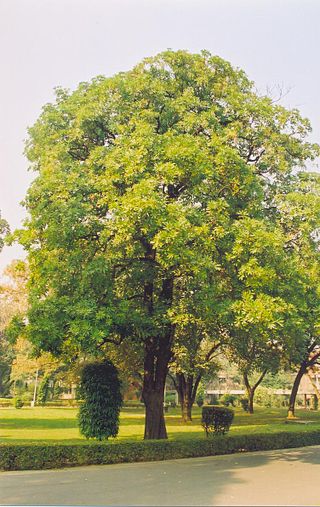
Alstonia is a widespread genus of evergreen trees and shrubs, of the family Apocynaceae. It was named by Robert Brown in 1811, after Charles Alston (1685–1760), professor of botany at Edinburgh from 1716 to 1760.

Solanum pseudocapsicum is a nightshade species with mildly poisonous fruit. It is commonly known as the Jerusalem cherry, Madeira winter cherry, or, ambiguously, "winter cherry". These perennials can be grown decoratively as house plants, but in some areas of South Africa, India, Australia and New Zealand it is regarded as a weed.

Dyera costulata, the jelutong, is a species of tree in the family Apocynaceae. It grows to approximately 60 metres (200 ft) tall with diameters of 2 metres, or even to 80 m (260 ft) tall with diameters to 3 m (10

Gomphocarpus physocarpus, commonly known as hairy balls, balloonplant, balloon cotton-bush, bishop's balls, nailhead, or swan plant, is a species of plant in the family Apocynaceae, related to the milkweeds. The plant is native to southeast Africa, but it has been widely naturalized. It is often used as an ornamental plant.

Parsonsia is a genus of woody vines in the family Apocynaceae. Species occur throughout Indomalaya, Australasia and Melanesia.

Parahancornia is a genus of flowering plants in the family Apocynaceae, first described as a genus in 1922. It is native to South America.

Rauvolfioideae is a subfamily of the flowering plant family Apocynaceae. Many species are woody lianas, others are shrubs or perennial herbs.
Alstonia boonei is a very large, deciduous, tropical-forest tree belonging to the Dogbane Family (Apocynaceae). It is native to tropical West Africa, with a range extending into Ethiopia and Tanzania. Its common name in the English timber trade is cheese wood, pattern wood or stool wood while its common name in the French timber trade is emien.

Hemidesmus is a genus of plants in the family Apocynaceae, first described in 1810. It is native to the Indian Subcontinent.
- Hemidesmus cordatus(Poir.) Schult. - India
- Hemidesmus indicus(L.) R. Br. ex Schult. - Pakistan, India, Bangladesh
- Hemidesmus indicus var. pubescensHook.f., syn of Finlaysonia wallichii(Wight) Venter
- Hemidesmus pubescensWight & Arn., syn of Finlaysonia wallichii(Wight) Venter
- Hemidesmus wallichiiWight, syn of Finlaysonia wallichii(Wight) Venter
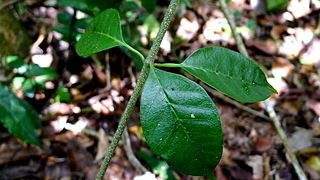
Condylocarpon is a genus of flowering plants in the family Apocynaceae first described as a genus in 1822. It is primarily native to South America, though found also in Trinidad & Tobago and Nicaragua.
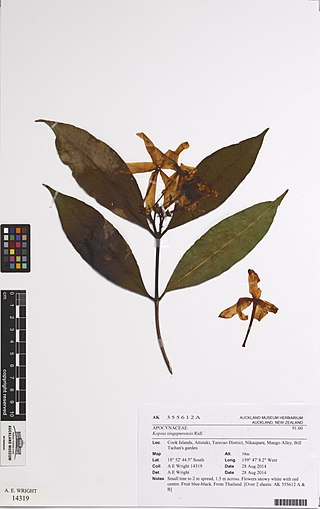
Kopsia singapurensis is a species of plant in the family Apocynaceae. It is native to Peninsular Malaysia and Singapore. It is threatened by habitat loss. It can grow up to five metres tall. When the plant is cut, white latex is produced. The flower has five petals. In Singapore, the tree can only be found in the Nee Soon Swamp Forest. In the wild, it flowers only twice a year, but when cultivated, it is free-flowering if grown under the right conditions.

Macoubea is a genus of plant in the family Apocynaceae first described as a genus in 1775. It is native to South America and Central America.
Spongiosperma is a genus of plant in family Apocynaceae first described as a genus in 1988. It is native to the South America, nations of Venezuela, Colombia, and Brazil.

Cosmostigma is a genus of plants in the family Apocynaceae, first described as a genus in 1834. It is native to tropical and subtropical Asia.
- Cosmostigma cordatum(Poir.) M.R.Almeida - India, Sri Lanka
- Cosmostigma hainanenseTsiang - Hainan Province in China
- Cosmostigma philippinenseSchltr. - Philippines
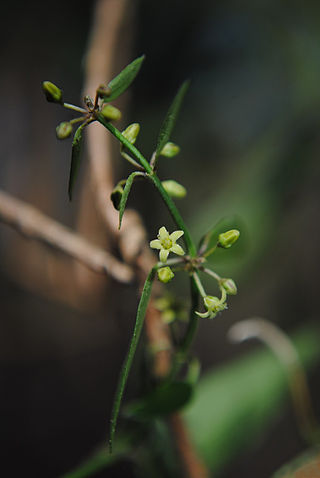
Orthosia is a genus of plants in the family Apocynaceae, first described as a genus in 1844.
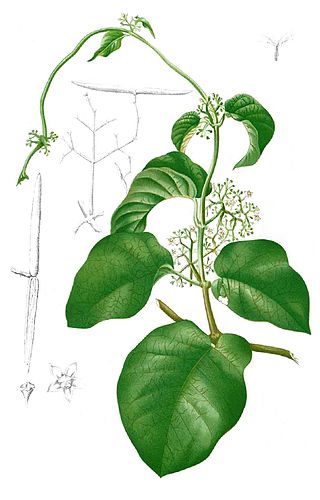
Streptocaulon is a genus of plants in the family Apocynaceae, first described as a genus in 1834. It is native to India, China and Southeast Asia.

Tabernaemontana africana is a species of plant in the Apocynaceae family. It is found in tropical Africa. It is an evergreen perennial shrub with a maximum height of 6 meters. The plant can be used to produce latex, soap and dye.
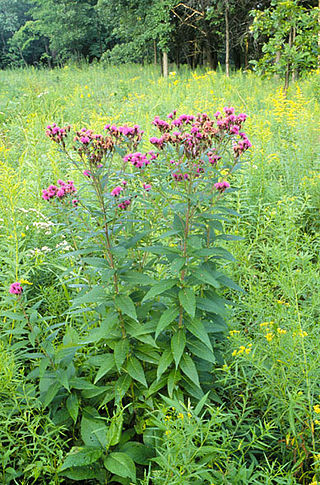
Vernonia fasciculata, the smooth ironweed or common ironweed, or prairie ironweed is a species of perennial plant in the family Asteraceae. It is native to Manitoba in Canada and the north-central U.S.A.
















